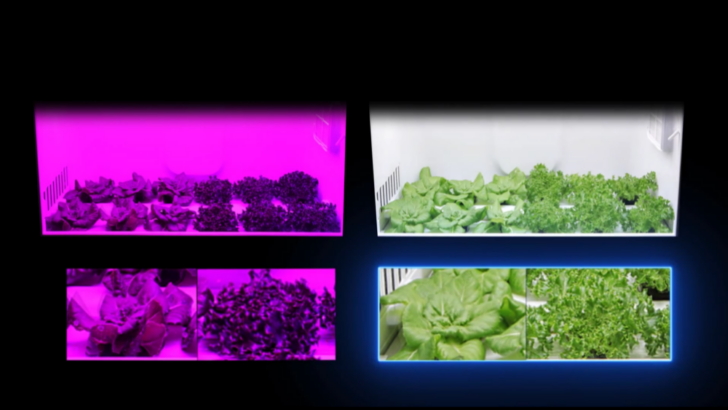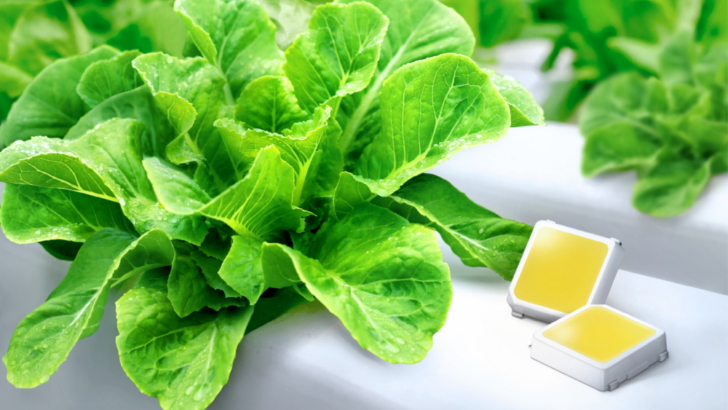[Going Green 3] [Interview] Lighting the Way: Professor Changhoo Chun Discusses Samsung’s Horticulture LEDs for Vertical Farming
on April 29, 2019
A ‘smart farm’ is an intelligent farming system that applies information and communication technologies (ICT) to agriculture. One example of a smart farming system is vertical farming, wherein food is produced in vertically stacked layers. Vertical farming has been attracting attention in recent times as a potential future agricultural model thanks to the advantages it offers, including its economical use of space and resources, environmental-friendly form of cultivation, and the reliable harvesting.
Samsung Electronics last year entered the ‘future food’ industry by introducing its full-spectrum white-based horticulture LEDs for vertical farming. To find out more about what this means for the future of agriculture, Samsung Newsroom sat down with Professor Changhoo Chun (College of Agriculture and Life Sciences, Seoul National University), adviser to Samsung’s horticulture LED development process and an authority on plant growth, to discuss ‘future food’ and the role technology has to play in this.

Q. What led to the adoption of agricultural techniques like vertical farms? What benefits do they offer to people?
“Nowadays, a number of factors have led to an increasing need for agricultural innovation in order to meet consumer demand, including an ever-growing global population and the negative effects industrialization and global warming are having on the soil fertility of arable land. Vertical farming, which has grown increasingly popular in places like Europe, the U.S. and Japan, is one such innovation that has the potential to meet the growing need for healthy, abundant food sources.
Vertical plant farms cultivate produce indoors and are pest-free, meaning that the crops do not require pesticides. Thanks to this, the vegetables produced in these plant farms do not require a separate washing process – people can enjoy these fresh vegetables straight from the packet. The controlled, intelligent system that vertical farms incorporate provides the best possible growth environment, meaning that the resulting produce is rich in both taste and nutrition. Additionally, given that these vertical plant farms are indoors, they are exempt from climate events that might affect plants grown outdoors, such as bad weather and fine dust.”
Q. What plants can be grown in vertical plant farms?
“Well, in order to grow properly, plants need exposure to a few essential elements, such as light, moisture and certain nutrients. Vertical plant farms provide all these necessary elements, meaning that theoretically speaking, all manner of plants can be produced in these plant farms.
However, when the supply-and-demand of certain produce types is taken into account, it makes the most sense to use vertical farms to chiefly cultivate those plant species that can mature fully in a short period of time and are no longer than 20 to 30 centimeters – so that they can grow in vertically stacked layers in one room. Produce types that fit these criteria include herbs, lettuce and arugula.”

Q. What role do the LEDs used in plant factories play? Do they replace the need for natural light?
“Light is a very important factor in plant growth, and fortunately enough, LED lighting, which is becoming widely used across vertical plant farms, is able to go above and beyond what natural sunlight offers to the produce-cultivating process.
Plant photosynthesis, germination and growth all depend on the wavelength of light the plant is exposed to. LED lighting is able to provide the optimum lighting conditions for growing any plant because it is easy to adjust an LED’s wavelength. Different light wavelengths can affect the taste and nutrient content of different types of plants. Even sometimes within the same species, vegetables can end up tasting bitter. This matching of the right wavelength to the right vegetable is called a ‘lighting recipe’.”

Q. What is the ‘full-spectrum’ aspect of the white-based horticulture LEDs that you have developed in collaboration with Samsung Electronics?
“In the first plant factories, a combination of red and blue lights was mainly used to aid produce cultivation because at that time, researchers had found that plant growth was most affected by the wavelengths of red and blue lights. However, the red and blue lighting made it difficult to monitor the color of a leaf or the overall development of a plant.
More recently, researchers studying the relationship between plants and light have highlighted the importance of green light wavelengths to a plant’s growth. The results now show that plants absorb green light best, compared to LED lights of other colors. This is why we developed a ‘white’ light – it is a blend of all three lights colors. Samsung’s full-spectrum white-based horticulture LED modules harness a wide spectrum of wavelengths, making it more effective in indoor farming.”
Q. What are the advantages of the full-spectrum white-based horticulture LEDs?
“Growing plants well comes down to providing the right combination of wavelengths specific to each type of plant – from vegetables to fruits to medicinal plants. However, finding the optimum for each type of produce is often time-consuming and costly – a difficult undertaking for most vertical farms.
This collaboration with Samsung, a world leader in LED technologies, focused on finding the optimal combination of light wavelengths necessary for peak plant growth. In order to do this, the most in-demand produce from existing plant factories were documented and then experiments on them were conducted with various combinations of light wavelengths. From the results of these trials came Samsung’s lighting solution lineup, including the full-spectrum white-based horticulture LEDs. These products are expected to be a great help not only for existing large-scale plant farmers, but also for novice indoor growers, farmers who want to try cultivating new crops, and the plant factory industry as a whole.”

Q. What role do you expect Samsung to play in the future food and agricultural sectors?
“Samsung has been working closely with agriculture research teams to come up with new technologies and products that can contribute to the development of the plant growth field, an undertaking that I see as particularly meaningful. This collaborative work will definitely provide good synergy to the future food and agricultural sectors.
Samsung’s latest product, Chef Garden, helps consumers grow their own herbs right inside their own kitchens. I hope that the first-hand experience Chef Garden grants consumers sparks gratitude and curiosity in them towards agriculture and where the food we eat comes from.”


